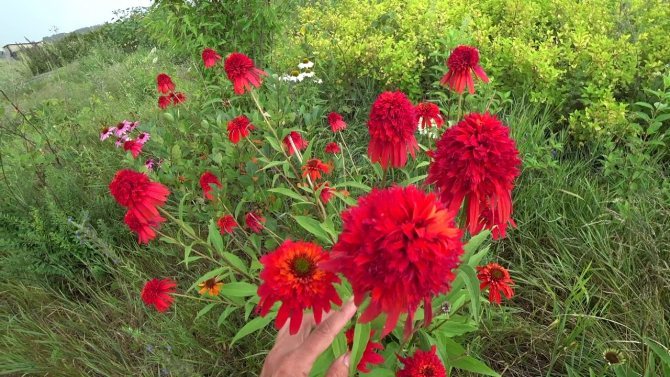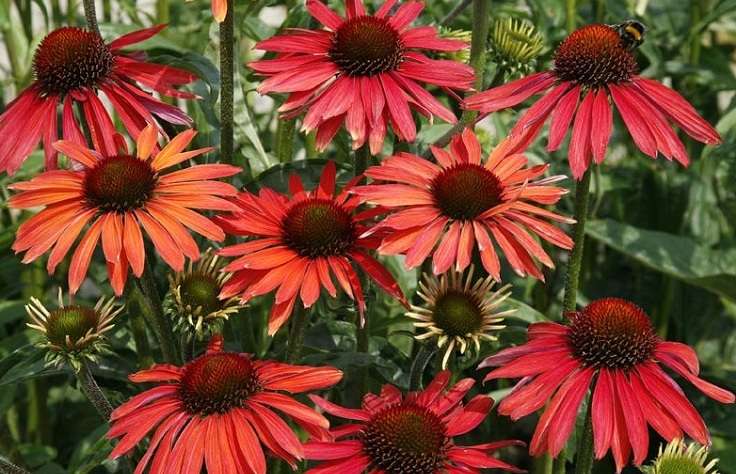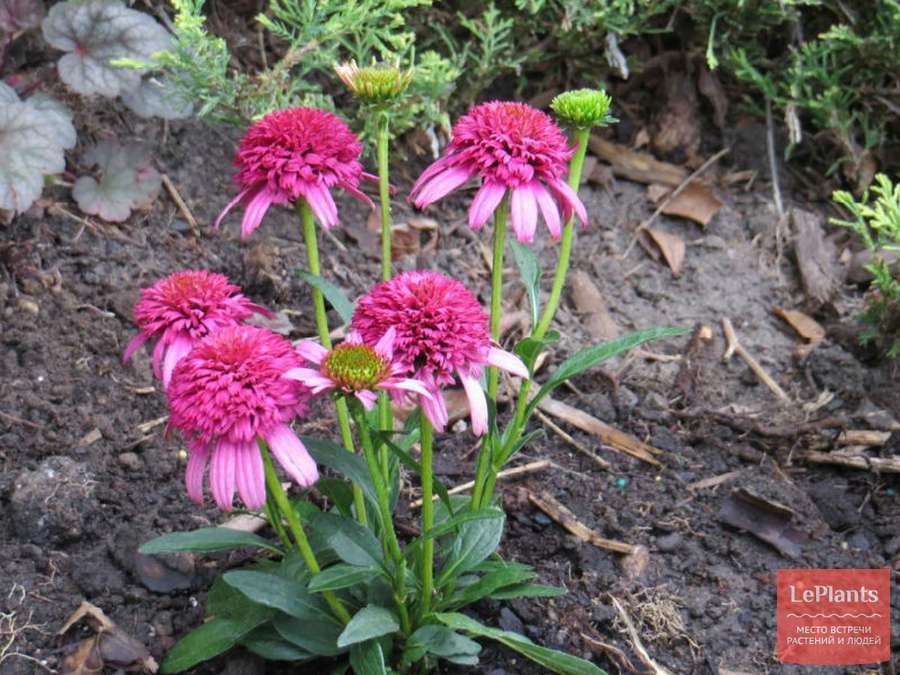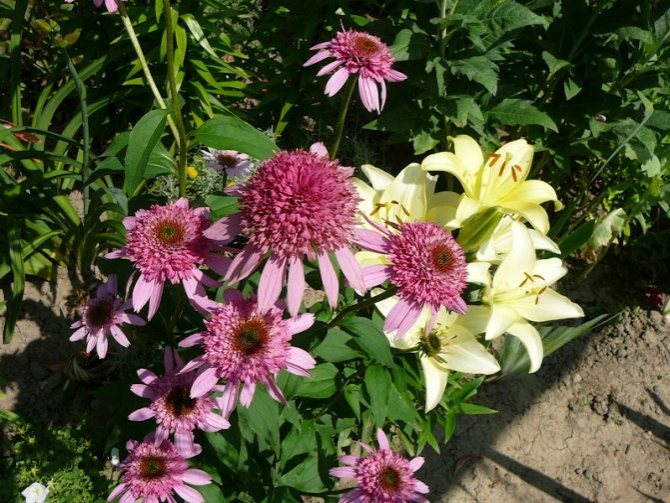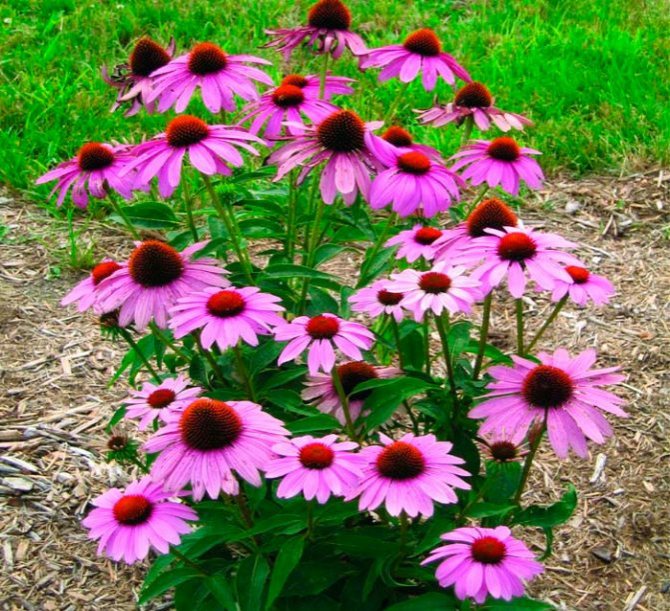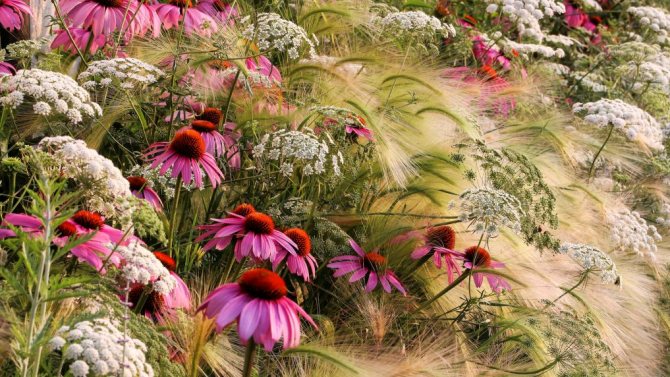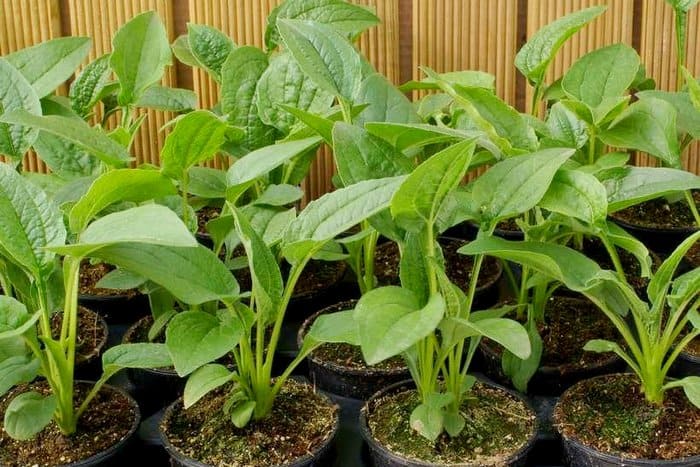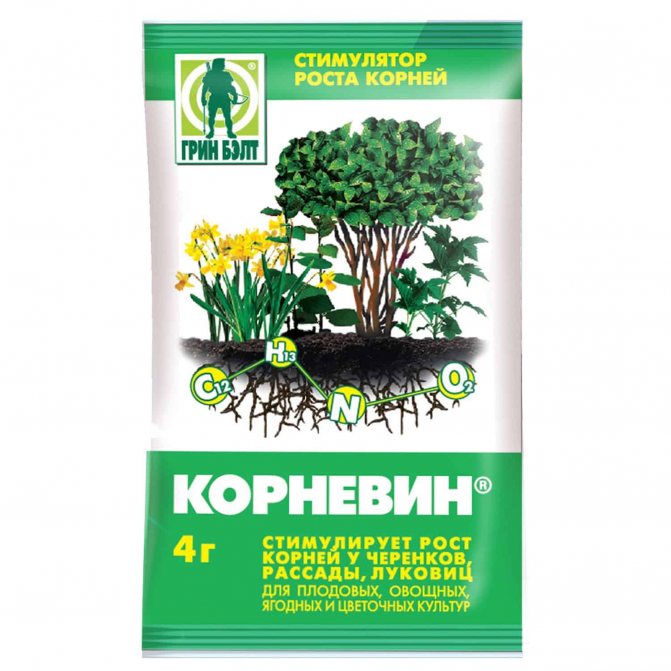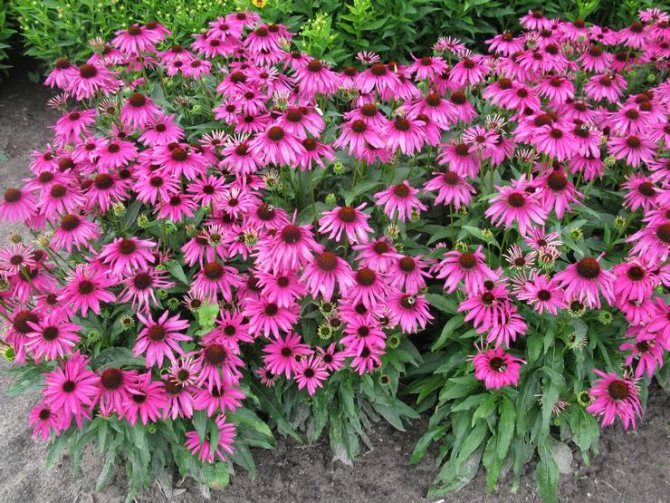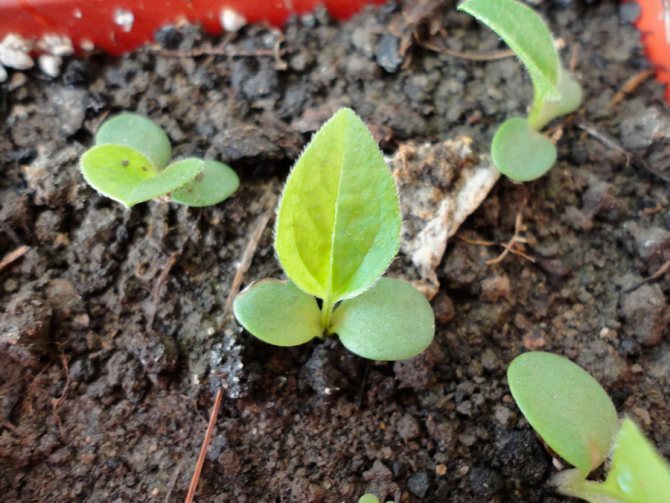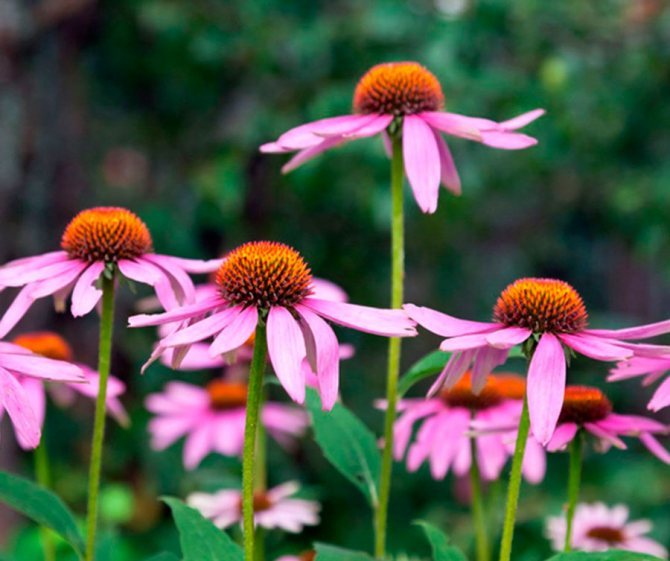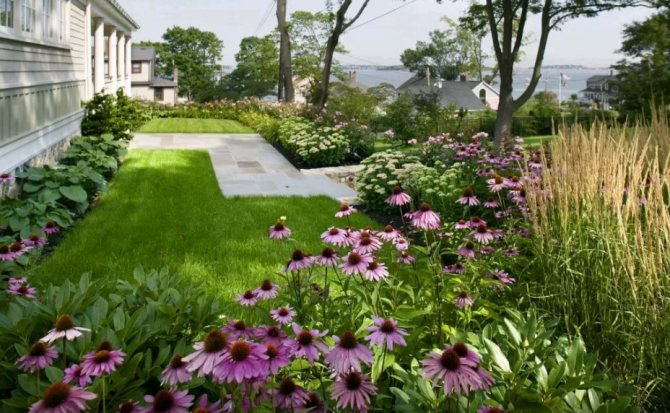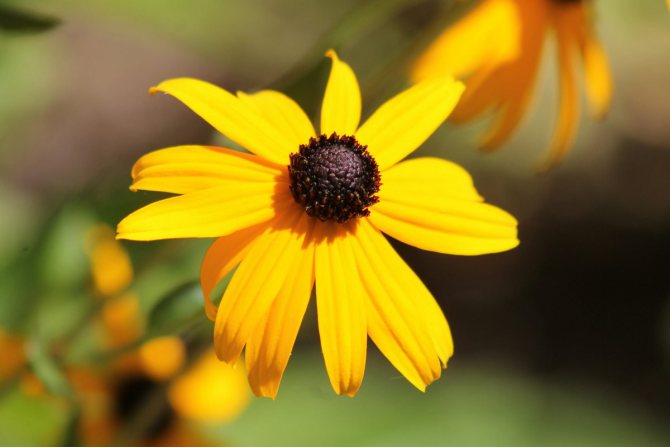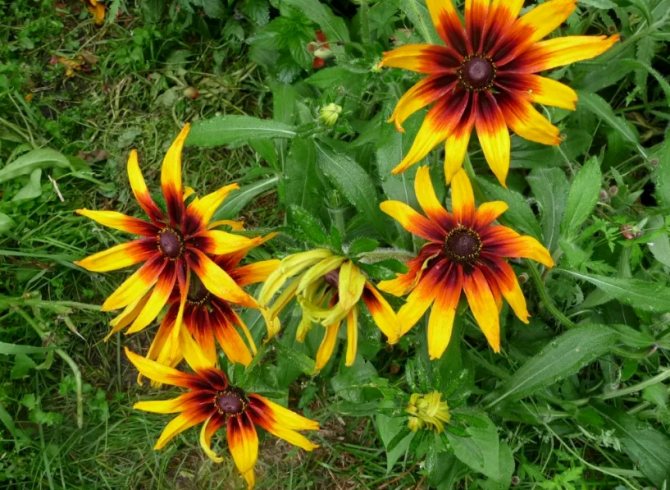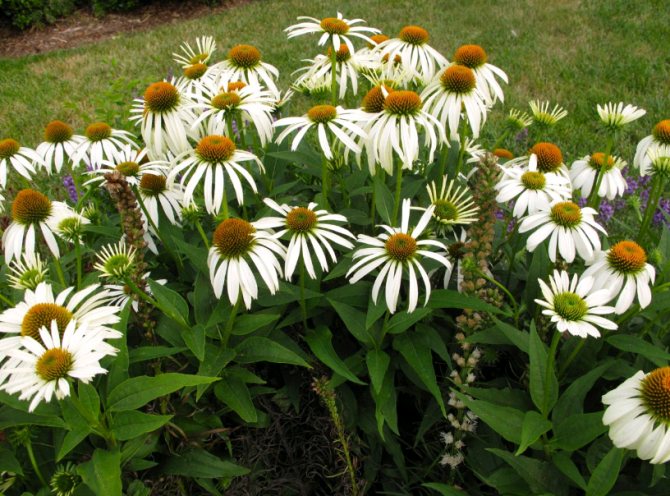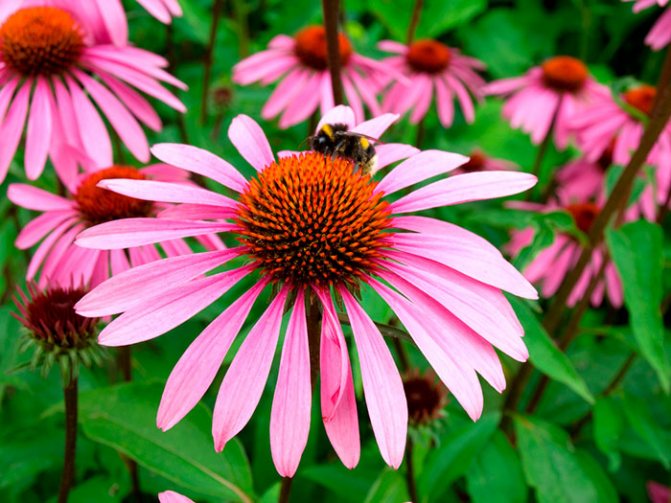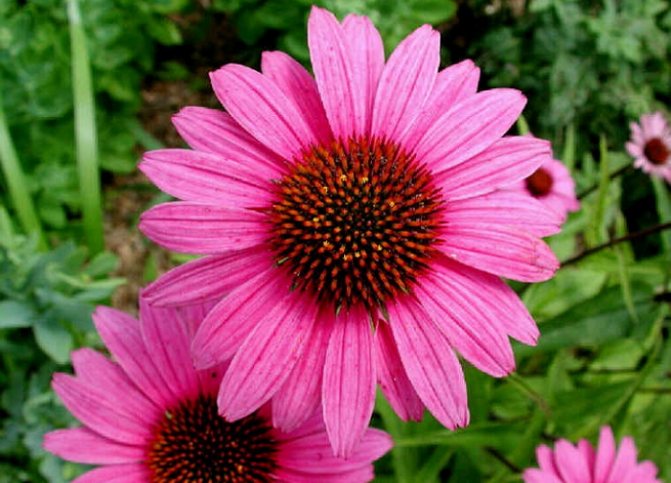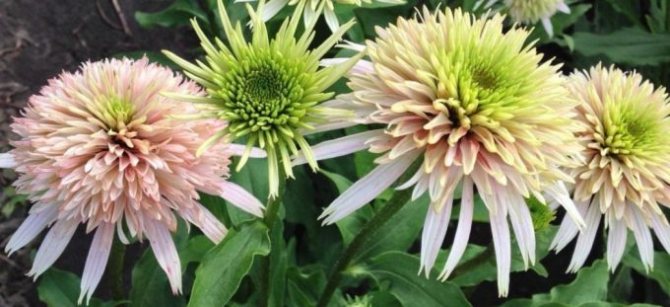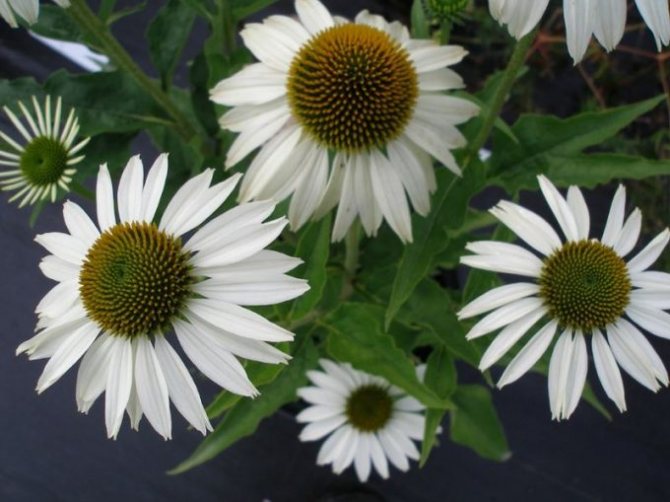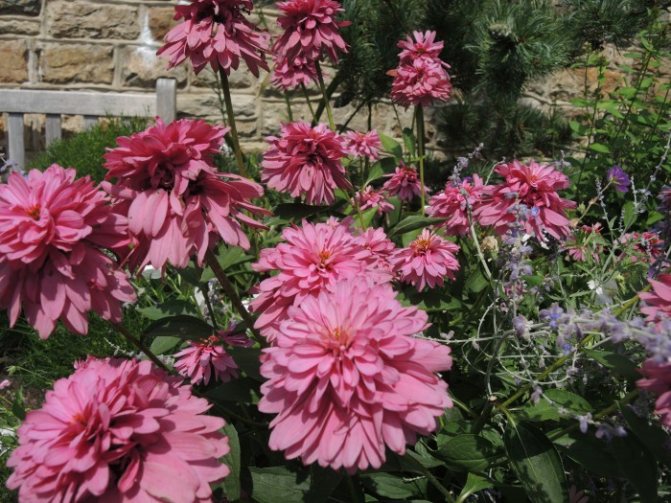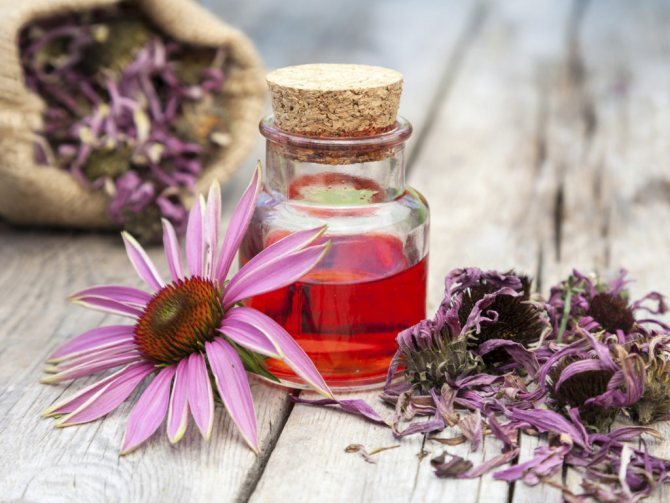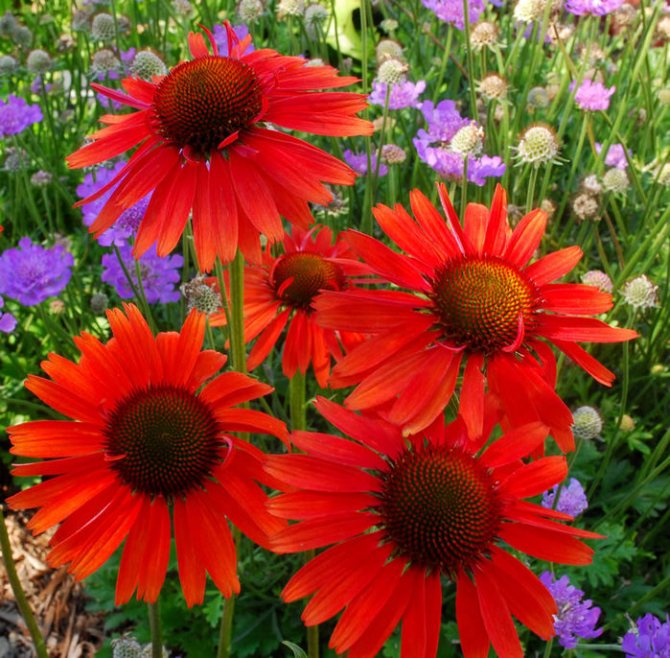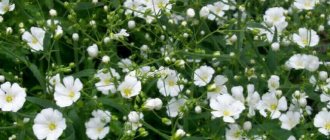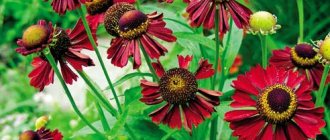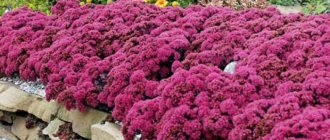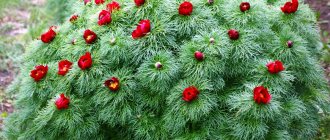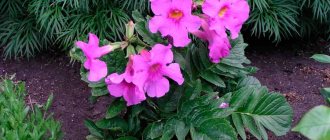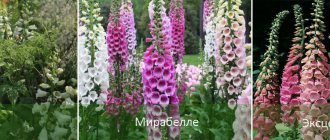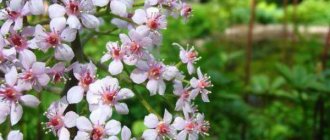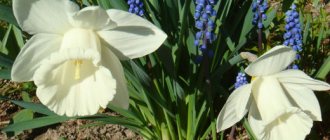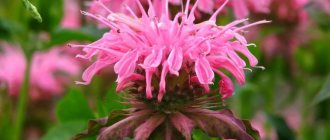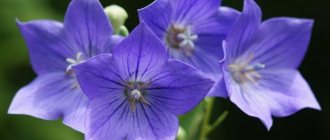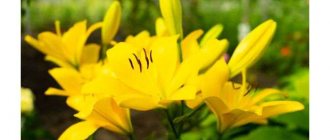Echinacea is a real find for the gardener, as it has many beneficial properties. It is a medicinal herb that is widely used in medicine and protects against colds. If you plant echinacea next to vegetables, it will attract bees to them and contribute to pollination. In addition, the culture has many varieties, so it will be an excellent garden decoration. The plant is not capricious and undemanding, but the gardener still needs to fulfill some conditions for a beauty to live on his site echinacea: grown from seed, caring for young and adult plants.
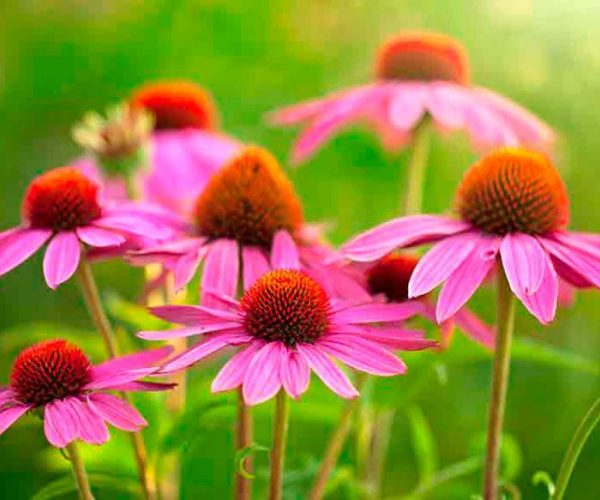
Echinacea - garden decoration
Features and types
Echinacea is a perennial from North America that belongs to the Asteraceae or Asteraceae family. It is a tall plant with a straight stem and a rough surface, which grows up to 1.5 m in height, with green basal and stem leaves. Wide basal roots form a lush rosette above the surface of the ground, stems are located slightly higher, one after another, in the shape of a lancet. The root system is strong, branched, so that Echinacea can grow in one place for about 10 years.
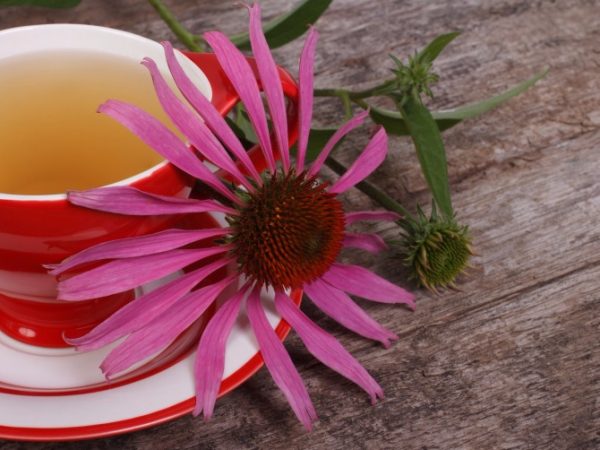

Echinacea, "born" on the North American continent, is often referred to as "American chamomile"
The flowers of the plant resemble a large chamomile - the center is convex, spherical or conical in shape with hard bristles. Thanks to this feature, the culture got its name - in translation from Greek, echinacea means "hedgehog". After the petals, which can have different shades (most often pink, purple or white, but there are other colors), fall off, the flower resembles a hedgehog.
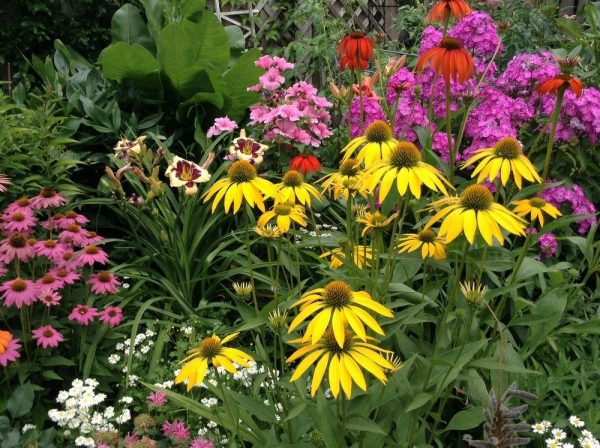

Echinacea is widely used for decorative purposes.
There are five main types of echinacea - by crossing them, breeders obtain varietal varieties with different petals (double, semi-double, omitted, etc.) and a varied palette of shades.
Table 1. The main varieties of echinacea.
| Name | Description |
| Purple | The most common species, widely used in medicine and horticulture. Feature - large inflorescences with pinkish-purple petals and an orange center. Can live in one place for more than 10 years |
| Narrow-leaved | A variety of plants in the form of small bushes 60-70 cm high with lanceolate leaves and small pink flowers-baskets. It is considered the most unpretentious and hardy, life expectancy is 5-6 years |
| Strange | Stems are straight, do not branch, the plant blooms in early July with yellow inflorescences. It is rarely used in horticulture - it is usually found naturally in the vastness of Canada and the USA |
| Pale | Branched stems grow up to 1.2-1.5 m, flowers are small, 5-6 cm in diameter, unlike other varieties of a flower, it is considered a juvenile. Echinacea pallidus, like the special one, is rarely used for decorative purposes. |
| Tenessian | The bushes are low, compact, and in appearance the plant resembles purple echinacea, but its inflorescences are smaller - about 2.5 cm in diameter |
Advice! There are about 40 varietal varieties of echinacea, but in horticulture, medium-sized (70-80 cm high) and dwarf (35-40 cm) varieties are most often used.They are widely used in any decorative composition. If the plant is to be grown for therapeutic purposes, purple echinacea is the best choice.
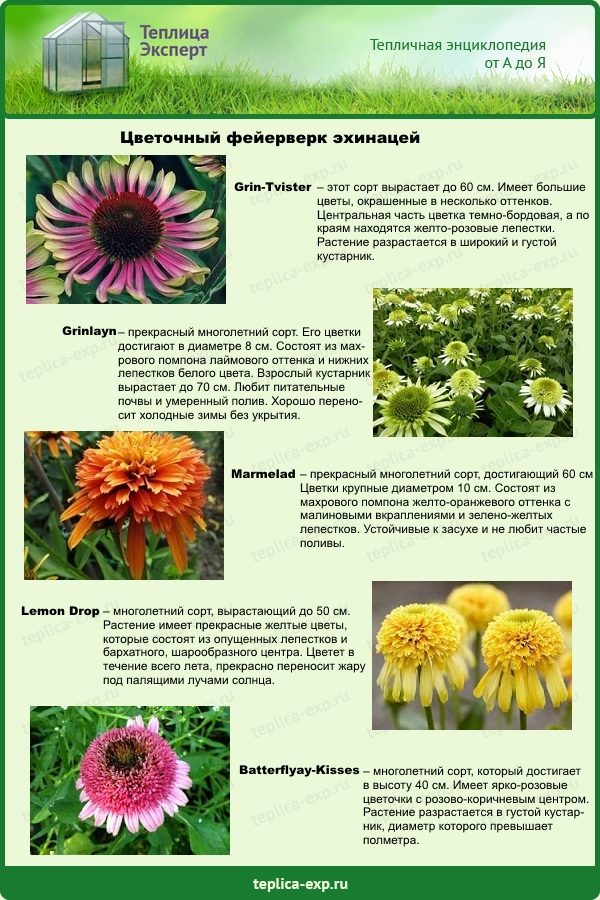

Flower fireworks echinacea
Echinacea seed prices
echinacea seeds
New types of echinacea
Variety "Yulia" - a type of plant decorates gardeners' backyards with its orange flowers. The people have already given him a new nickname - "Butterfly Kisses". A dwarf variety of echinacea will perfectly decorate a small space. It grows no more than 40-45 centimeters in height.
Popular: The exotic beauty of amorphophallus, a flower with an unpleasant odor
The variety prefers to grow in an open sunny area, it can tolerate hot summers quite normally. Abundant flowering occurs early enough, already at the beginning of the summer season, its large heads flaunt in the flower beds. The decorative flower can be added to various bouquet arrangements.


Double Scoop Cranb variety
The plant is particularly attractive to bloom. No one can indifferently walk past him, how handsome he is. Passers-by are struck by the bright color of Echinacea, similar to a bloody mountain ash. Looks appropriate in joint plantings with Russian sage.
In addition to other extraordinary advantages, the plant can boast of other positive qualities, for example:
- the flower is quite tolerant to dry weather;
- echinacea of the Double Scoop Cranb variety is unpretentious in care;
- attracts beneficial insects with its beautiful appearance.
The flowering of this plant can be admired all summer long.
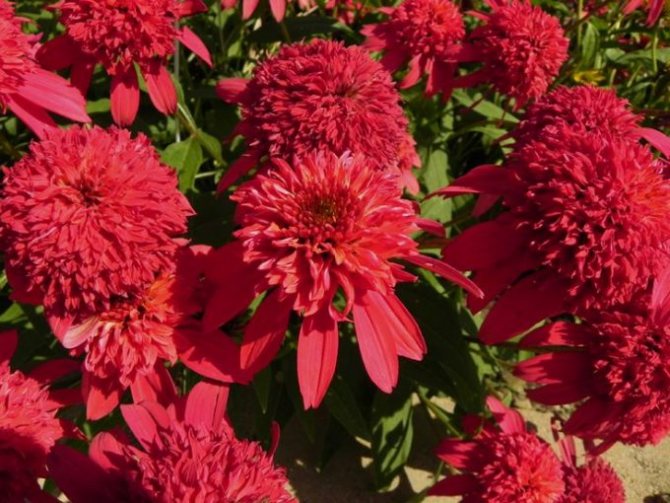

Variety "Flute of Passion"
Echinacea has evolved significantly over the past decade. This variety is distinguished by the curl of the petals. Outwardly, they resemble a musical trumpet - a flute, from the outside this sight is unusual. The bred variety was crossed with the equally famous pink Echinacea variety All That Jazz.
The new variety took for itself the curl of the petals, but it differs in color - the inflorescences are painted in a golden yellow color. The plant is quite tall, in some cases the flower height is 1-1.2 meters. Flowering is not long, only 2-3 months.
The variety is distinguished by its hardiness in dry weather, like many echinacea, it does not show capriciousness in its care. In winter, unharvested flower heads are food for forest birds.
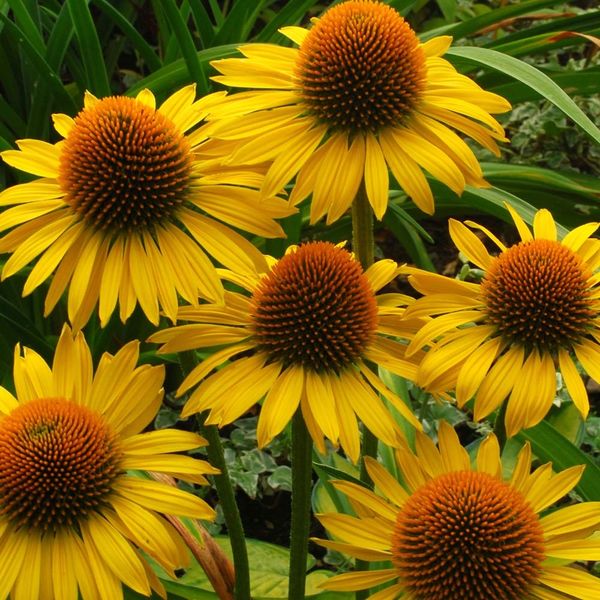

Growing from seeds
Echinacea can be grown both by seedlings and by sowing seeds in an open area - the plant takes root well in both cases, but each option has its own characteristics and rules.
Sowing in the ground
In an open place, the culture is sown in spring or autumn, but the second option is more preferable, since the seed has a hard shell, which takes time to soften. The planting site should be well lit - in the shade or partial shade, the culture grows very poorly, and may even die.
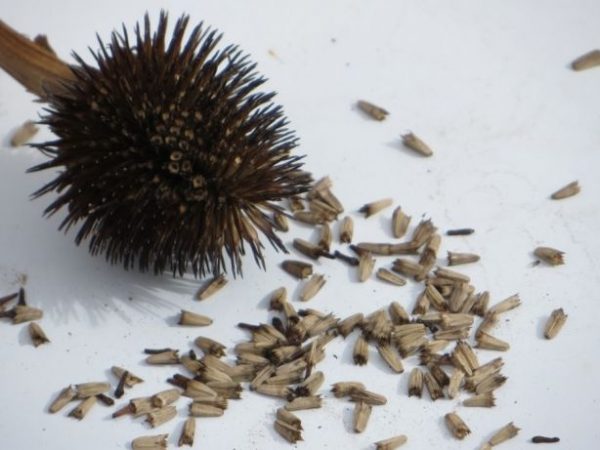

Echinacea seeds can be sown directly on the site or grown into seedlings
Echinacea is undemanding to the composition of the soil, but "does not like" light sandy soils, and feels best on slightly alkaline or neutral soils without excessive moisture. In a soil that is too acidic, it is better to first add lime, and fertilize the sandstones with humus and fertile soil from another site. Despite the unpretentiousness of echinacea, the place for its cultivation must be chosen carefully, since the plant will live there for at least 5 years.
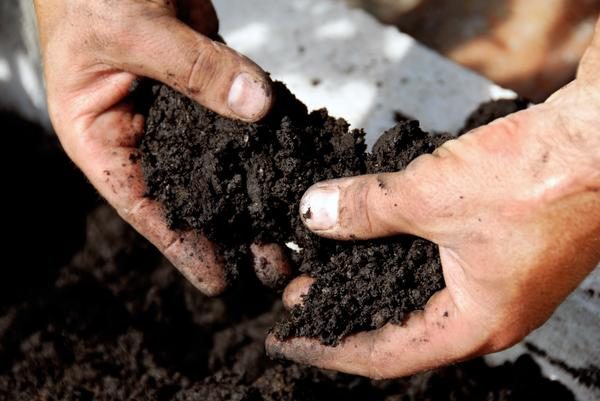

The soil for sowing echinacea should have a minimum acidity
The algorithm of actions is as follows:
- dig up the soil, level it, make grooves 1-2 cm deep at a distance of 20-25 cm, after which sow seeds as rarely as possible;
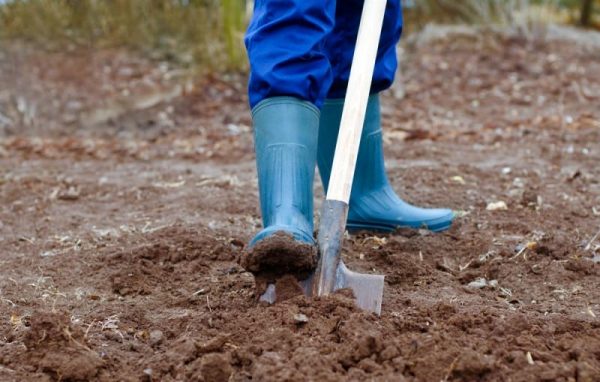

Before sowing, the soil is dug up
- as soon as the first shoots appear, they need to be thinned to an interval of 7-8 cm, after they grow up, repeat the procedure, leaving a distance of 10-15 cm.Mature shrubs should be spaced 25-30 cm apart for dwarf varieties and 40-50 cm for tall plants;
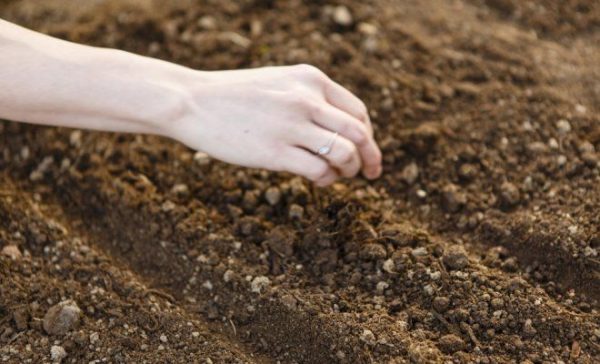

In open ground, the plant is sown in spring
In the first year of life of echinacea, only the root system develops, and flowering begins only the next summer.
For reference! If you sow echinacea seeds in winter to get seedlings, you can expect the appearance of flowers in the summer, and with other planting options, the plant will begin to bloom only in the second year.
Humus prices
humus
Growing seedlings
To grow seedlings, you should prepare a nutrient mixture from fertile soil, sand and compost (ratio 2: 1: 1) or take ready-made storey soil. In both cases, it is better to disinfect it by steaming it well in the oven and spilling it with a weak solution. potassium permanganate... Sowing should be carried out in early February - then in May you can get healthy, strong seedlings. Any suitable boxes or pots can be used as containers, the only condition is that they must have holes for the outflow of liquid so that moisture does not stagnate at the roots. The optimal temperature conditions for growing echinacea are 15-18 ° C, but the culture grows well at higher temperatures.
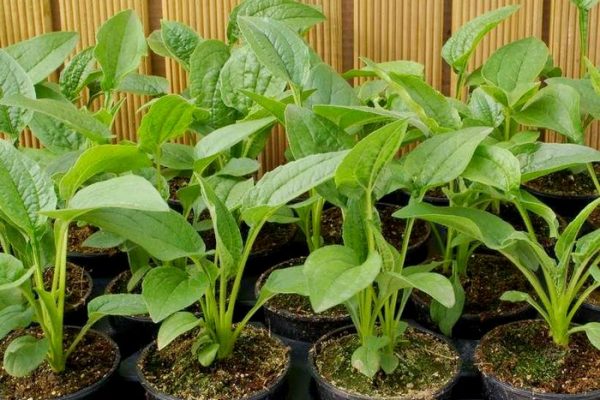

Echinacea seedlings can be bought in the store or grown by hand
Table 2. Step-by-step instructions for sowing echinacea for seedlings.
| Step, no. | Description |
| Step 1 | Expanded clay or other drainage will be laid at the bottom of the selected containers, fill them with a substrate |
| Step 2 | Before sowing, it is better to keep the seeds in a stimulant preparation (for example, Epin) or simply in warm water. They should be wrapped in a damp cotton rag, placed on a plate and kept moist at all times. You can skip this stage and plant seeds directly into the ground, but the procedure significantly accelerates growth. |
| Step 3 | Since echinacea seeds sprout uncommonly, it is better to plant them as they hatch. Make grooves in the ground with a depth of 7-10 mm, lay the hatched seeds, lightly cover with substrate, spray with a spray bottle and cover with glass or film |
| Step 4 | As soon as the first shoots appear, the film must be removed and the containers must be placed in a well-lit place. |
You can expect the first shoots in 35-40 days. Seedling care is simple - it needs to be watered regularly as the soil surface dries up, and in early May, start hardening. To do this, the containers are taken out into the air, first for 10-15 minutes, gradually extending the time spent outside.
Attention! When choosing or preparing a soil mixture for growing echinacea seedlings, you need to take substrates that do not contain peat - it will slow down the already slow germination of seeds.
Planting echinacea in the ground
When to plant. Like most flowers, echinacea is planted in the garden when the threat of frost has passed, usually at the end of May.
Landing place. Echinacea is recommended to be planted in the sun, but based on my own experience, I can say that it feels great in partial shade. Even in partial shade, the color of flowers is richer and brighter. Of course, these flowers cannot be planted in the shade, there the flowers will be small and may disappear altogether.
The soil. Echinacea can grow in almost any soil. If the ground is very sandy, then add some good earth or humus when planting.
Planting echinacea. The grown seedlings are planted in flower beds at a distance of 30 cm, the holes are made not deep 10 - 15 cm. If you bought already grown plants, then the planting holes are prepared more, focusing on the size of the roots. After planting, water the seedlings and mulch the soil.
Planting echinacea in the ground, video:
Landing in an open place
Since echinacea seedlings are very delicate, it is better to plant them in an open place at the end of May, when the threat of a significant drop in temperatures is over.In the selected area, you should dig holes with a diameter slightly larger than an earthen coma, the distance between them is at least 30-40 cm, depending on the variety. At the bottom of each of them, put a handful of compost mixed with a pinch of wood ash, transfer the seedlings there, trying not to shake the earth from the roots and not damage them. After that, cover the young plants with earth and water abundantly.
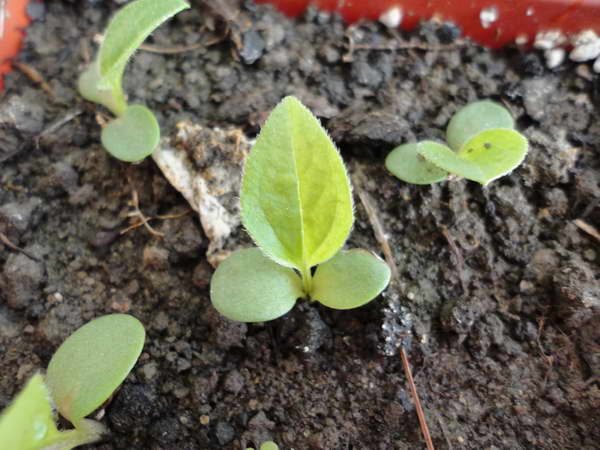

Echinacea seedlings are transferred to the garden plot after the onset of stable heat
Procurement and storage
Harvesting of leaves and roots is carried out at the beginning of summer, when the active growing season begins. The culture is carefully removed from the soil, after which the lateral and adventitious roots are cut off. Drying of the rhizome is carried out after thorough rinsing in an oven or dryer. The foliage is dried either in dryers or on a flat surface, with good ventilation and no sun. The harvesting of flowers is carried out at the beginning of flowering. After drying, the ready-made mixtures are stored in dry jars or cloth bags in a dark and warm place.
Planting care
Echinacea does not require special care, but plantings cannot be left unattended either, otherwise they will lose their decorative appearance and may die.
- planting should be watered sparingly, but regularly, preferably in the evening. Plants tolerate short-term drought normally, but in the absence of watering for a long time, they will dry out. Excessive watering is also harmful for echinacea - with stagnant moisture, the petals will be too pale and quickly fall off;
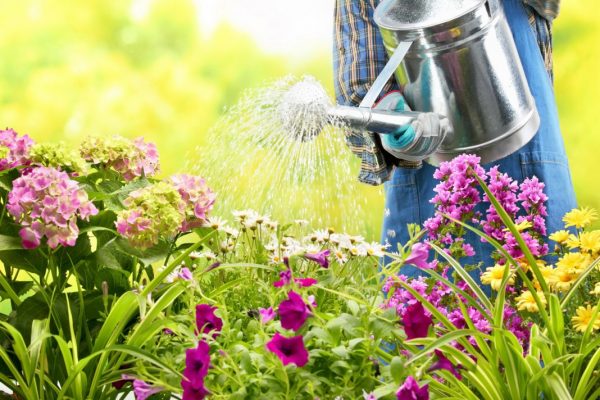

The main thing in plant care is proper watering.
- in the area where the crop grows, you need to regularly remove weeds and loosen the soil after each watering in order to improve its air permeability;
- you need to feed the plants twice a season, starting from the second year of life. In the spring, mixtures with a nitrogen content are introduced into the soil, and during the period of the appearance of the first buds - potassium and phosphorus. Mineral fertilizers can be replaced with rotted compost mixed with wood ash;
- to stimulate flowering, dried inflorescences must be cut to the first leaf. If you need to collect seeds for subsequent sowing, you should leave several of the largest flowers on the bush;
- to collect the seeds, you need to wait until the petals fall off, and the middle darkens slightly, then carefully collect the seeds, clean them of dust and dry them. Since the seed does not differ in good germination, it is better to plant it as soon as possible;
- once every 3-4 years, it is recommended to rejuvenate echinacea by dividing the bush - dig up the plant, divide the root so that there are several buds on each part, and plant them;
- before the first frosts near the bushes, the entire aboveground part should be cut off, the remaining part should be mulched with a thick layer of compost, and covered with spruce branches or dry foliage on top.


It is better to remove the seed boxes to avoid self-seeding.
Important! If echinacea is planned to be used for therapeutic purposes, it is better to refuse mineral dressings, otherwise harmful substances will accumulate in the leaves and flowers.
Wood ash prices
wood ash
Video - Cultivation of Echinacea
Echinacea propagation by dividing the bush
Echinacea purpurea can also be propagated by dividing the bushes. This is done in early spring, when the leaves are just beginning to appear on the plants. It is necessary to divide the bushes in early spring, until the leaves have opened and the bases of the echinacea shoots are not lignified. Delenki and root cuttings for better root development are kept for several hours in a solution of a liquid immunostimulant, when planting, they are powdered with rooting powder. The root collars of the cut are not deepened when planting, they should be at the level of the soil.
Many flowering plants in modern industrial conditions are propagated mainly by the meristem method. This method allows you to quickly and easily obtain any number of required specimens of the desired varieties.In nurseries, Echinacea purpurea is often grown meristemally, and the resulting tiny meristem plants are usually sold in early spring. If you purchased just such plants, then they must be transplanted into pots with nutritious soil and kept in the shade, not forgetting to water.
After a month and a half, the plants are planted in a permanent place. Meristemic plants can be immediately planted in the soil, but then it is imperative to do something like a greenhouse for them, for example, cover them with large bottles without a bottom from under the water. Small "delenki" with good and proper care sometimes even try to bloom in the first summer, but they do not need to be allowed to do so.
In general, the cultivation of Echinacea purpurea is not overly difficult. And can be easily mastered by gardeners and gardeners.
Diseases and pests
Echinacea is considered a plant resistant to diseases and pests, but with the wrong choice of place for planting and non-observance of the rules of care, fungal diseases and harmful insects can strike it.
- Fungi... The most common echinacea disease is powdery mildewbut other illnesses can also occur. If a strange plaque is found on the plants, and the flowers and leaves are damaged, you need to dig up the affected bushes with the root and dispose of them. In case of recurrence of infection, the planting will have to be treated with fungicides based on copper sulfate or Bordeaux liquid.
- Pests... Among the harmful insects on the bushes of echinacea can be seen slobbering penny... If nests of this pest, similar to scraps of foam, are found, the plants should be treated with a mixture of infusions of tobacco dust with garlic or water laundry soap solution.
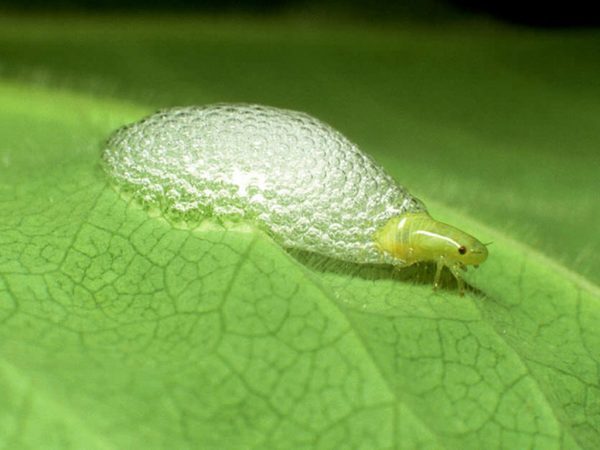

The slobbering penny is one of the pests of echinacea
Attention! Plants that have been treated with fungicides or other chemicals should not be used for therapeutic purposes, as this can be hazardous to health. Those who grow echinacea for use in traditional medicine recipes need to closely monitor the health of the plants, and use natural remedies to control pests.
Description
Echinacea is a perennial representing the Astrov family. According to other sources, the culture belongs to the Asteraceae family. Since this plant has long been considered a representative of rudbeckia, today Echinacea is often called that. The culture is a herbaceous or shrubby type of perennial plants growing upward, with straight stems reaching a height of one meter. The culture is unpretentious, easily takes root in any conditions, due to which it is planted in many places with an unfavorable climate.
Echinacea's rhizome is well developed and rather long, extending into the depths of the soil. The roots are light, consist of a central root and lateral root shoots. Erect, rough stems extend from the root collar. Shoots of light green color, quite fleshy and strong. Rudbeckia stems are often solitary, not branching, covered with small elongated leaves.
Leaves also extend from the root collar. The basal leaf plate of Echinacea is attached to the shoots with small petioles. The leaves emerging from the root collar are much wider and larger in size than those that grow from the shoots. This type of foliage has jagged, jagged edges and a rounded end. The length of the basal foliage often reaches more than 15 cm, with a width of about 7 cm. The leaf plates are painted in a rich green hue. The stems also have leaves that are attached in a non-petiolized way. Such foliage has a characteristic roughness and smooth edges. The shape of the stem leaves is elongated, with a pointed end. On the stems, the foliage is arranged alternately.
In the middle of summer, rudbeckia begins to form inflorescences.Flowers are located on long shoots - peduncles. The apical inflorescences are single, large, reaching about 15 cm in diameter. The core of the flowers is painted in a bright burgundy or brown shade. Elongated thin petals extend from the middle, which can be painted in a variety of tones. The petals of terry varieties are arranged in several rows, making the basket even more decorative. Flowering lasts from mid-summer until the onset of frost.
After flowering, in place of the core of the flower, a fruit is formed - a box with seeds, which is an achene, consisting of 4 cells. Seeds are small, brown or black, round in shape.
How to use echinacea for treatment
For the preparation of medicines, you can use any part of the plant, but the largest concentration of nutrients is found in the root. Products made from echinacea fight pathogenic microorganisms, increase immunity, heal wounds and calm the nervous system. For infectious diseases, they can be used as a natural antibiotic - they do not contain chemicals and stimulate the production of interferon directly in the body.
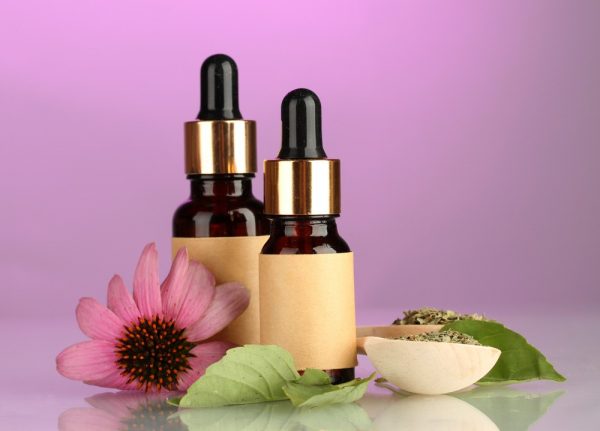

Echinacea is used to prepare medicines to fight infections and inflammations
Echinacea - not only a flower that will decorate your garden plot, but also a miraculous medicinal plant that contains many useful substances. If you spend a little time growing and caring for a crop, it will delight the eye for several years and protect against diseases.
The healing properties of echinacea


What is especially valuable about this plant is its antiviral and antiseptic properties. The elements contained in echinacea counteract the multiplication of pathogenic bacteria, viruses, infections. It is used in the treatment and prevention of influenza, tonsillitis, colds and diseases of the upper respiratory tract. Used as an anti-allergic, anti-inflammatory, anti-rheumatic agent. Echinacea successfully fights various fungal diseases, heals wounds and ulcers, strengthens the general immunity. And these are not all the beneficial properties of echinacea.
What is great is that almost all parts of the plant are suitable for the preparation of medicinal infusions, decoctions, etc.
Echinacea decoction
This simple remedy well eliminates pain in the joints, swelling, improves vision, and is used in the treatment of stomach ulcers. After taking such a decoction, the mood improves.
Preparation of the broth
Based on one glass of boiling water, a teaspoon of crushed echinacea leaves is taken. Moreover, you can use both fresh and dried leaves. Leaves filled with boiling water should be held for half an hour in a water bath. After straining and cooling, the broth is ready for use.
Receiving broth
The usual course of taking it lasts 10 days. It consists of taking 30 milliliters of broth three times a day after meals. If you need to take several such courses, then a week break between them is required.
Echinacea infusion
It is recommended if you are overweight, signs of the onset of obesity. It is used in the treatment of gynecological diseases, herpes. But its main and most common purpose is to strengthen the general immunity of the body.
Preparation of infusion
The infusion should be prepared in an airtight, well-sealed container. At the rate of half a liter, a tablespoon of echinacea (dried or fresh parts) is taken. A thermos is best for preparing an infusion of echinacea. If the infusion is prepared in the evening, then in the morning it will be ready.
Reception of infusion
Take the infusion for 10 days (if there are no individual recommendations), three times a day before meals (25-30 minutes), 100 milliliters at a time. After completing one course, there must be a break of at least 5 days.After three courses in a row, a break of at least a month.
Pay special attention! For all its naturalness, echinacea preparations may have contraindications. This is both an individual intolerance to the components of the drug, and an allergic reaction to them. Echinacea is also contraindicated in a number of diseases. Before you start taking it, consult your doctor!
Echinacea after flowering
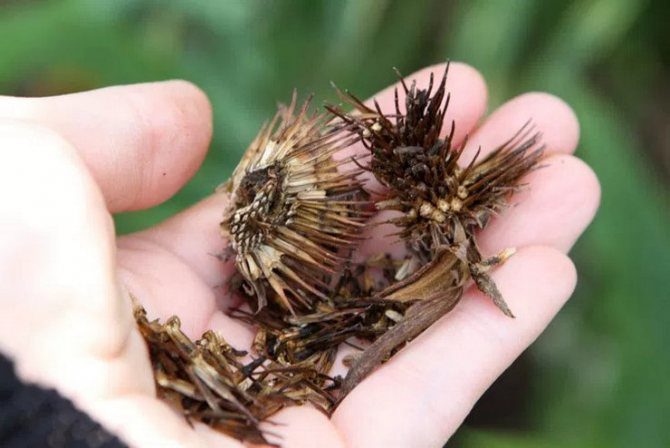

Seed collection
The collection of seed material is carried out gradually, because the seeds do not all ripen at the same time. The collection begins at the end of the summer season. The seeds are in the middle of the basket-shaped inflorescence. The maturity of the seeds is determined by the darkened center of the flower. It is more convenient to collect them with gloves. It is recommended to lightly dry the seed and sow it immediately in open ground, since its germination capacity remains for a very short time.
Preparing for winter
The cold-resistant plant will perfectly survive the winter without shelter in the presence of a large snow cover or in moderate cold. If your area is dominated by severe frosts in the absence of snow during the winter months, then it is worth taking care of the plants in advance. In the first year after planting, young crops definitely need a protective structure to keep warm. In the fall, around the last week of October, all stems are pruned and mulched. The compost mulch should cover the root collar, and on top the entire flower garden should be covered with a layer of fallen leaves and spruce branches.

